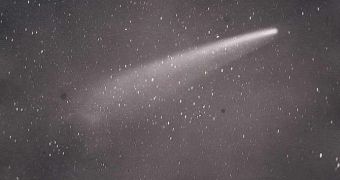Though researchers have been proposing for a very long time that comets contain vast amounts of water, this was never conclusively proven until only recently. A team of experts managed to get definite proof that the liquid can be found within these space wanderers.
Importantly, the debate that raged on in the international astronomical community was whether liquid water exists on comets, and not water-ice or other forms of the stuff. The new finding is critically important because it provides new support for a host of other theories that depended on this.
The new investigation was carried out of minute particles that were returned to Earth by the Stardust spacecraft in 2006, after a 2004 flyby of comet Wild 2. A sample-return canister containing the dust was parachuted through the atmosphere, before the spacecraft went on its way in the solar system.
Discoveries such as this one are critically important towards understanding how comets appeared and evolved, and also what role they played in the development of the early solar system.
A large number of astronomers believe that comets may have also been responsible for seeding life here on Earth. This theory, called panspermia, is strengthened once more by the new evidence.
An important implication of the research is that comets can get sufficiently warm to allow for the existence of liquid water on their surface. This means that their average temperature needs to climb above 0 degrees Celsius, or 32 degrees Fahrenheit, Space reports.
What puzzles experts about the new finding is the fact that comets can contain liquid water inside their bodies even if the bodies themselves are made predominantly of ice. Basically, the image the new study paints is one of an icy comet containing a liquid water core.
“Current thinking suggests that it is impossible to form liquid water inside of a comet,” explains University of Arizona expert Dante Lauretta, who is also a coauthor of the new investigation.
The expert is part of a UA team led by graduate student Eve Berger, that analyzed the Stardust data. The spacecraft managed to collect particles samples from the comet's coma, the layer surrounding the nucleus that is most visible as seen from Earth.
“When the ice melted on Wild 2, the resulting warm water dissolved minerals that were present at the time and precipitated the iron and copper sulfide minerals we observed in our study,” Lauretta explains.
“The sulfide minerals formed between 50 and 200 degrees Celsius [122 and 392 degrees Fahrenheit], much warmer than the sub-zero temperatures predicted for the interior of a comet,” the expert adds.
Details of the new work and its implication were accepted for publication in an upcoming issue of the esteemed journal Geochimica et Cosmochimica Acta.

 14 DAY TRIAL //
14 DAY TRIAL //